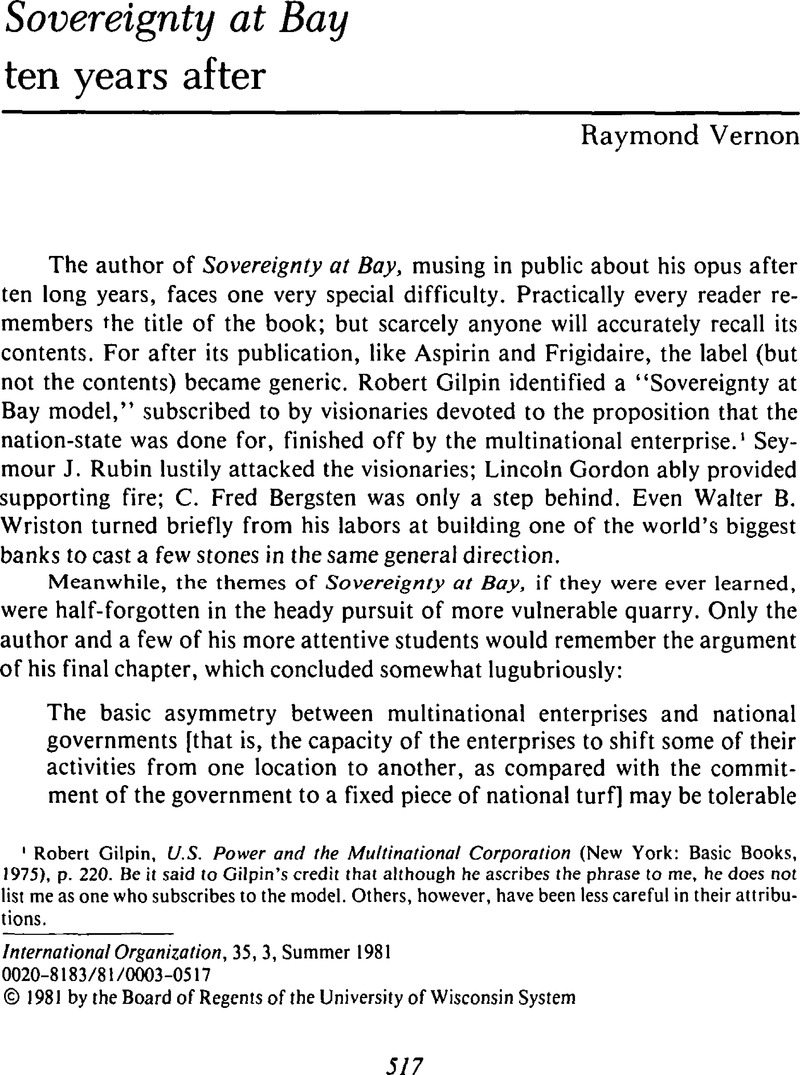Published online by Cambridge University Press: 22 May 2009

1 Gilpin, Robert, U.S. Power and the Multinational Corporation (New York: Basic Books, 1975), p. 220CrossRefGoogle Scholar. Be it said to Gilpin's credit that although he ascribes the phrase to me, he does not list me as one who subscribes to the model. Others, however, have been less careful in their attributions.
2 Hymer, S. H., The International Operations of National Firms: A Study of Direct Foreign Investment (Cambridge: M.I.T. Press, 1976)Google Scholar, based on his 1960 thesis.
3 See Knickerbocker, F. T., Oligopolistic Reaction and Multinational Enterprise (Boston: Harvard Business School, 1973)Google Scholar. His subsequent work on the hypothesis, unfortunately never fully published, went even further in confirming its utility.
4 The number of such studies by now is very large. Illustrations are: Wells, L. T. Jr, ed., The Product Life Cycle and International Trade (Boston: Harvard Business School, 1972)Google Scholar; Finger, J. M., “A New View of the Product Cycle Theory,” Weltwirtschaftliches Archiv 3, 1, 1975Google Scholar; Claudon, M. P., International Trade and Technology: Models of Dynamic Comparative Advantage (Washington, D.C.: University Press of America, 1977)Google Scholar; Hirsch, Seev, “The Product Cycle Model of International Trade,” Oxford Bulletin of Economics and Statistics 37, 4 (11 1975), pp. 305–17CrossRefGoogle Scholar; Hiroki, and Tsumuri, Yoshi, “A Bayesian Test of the Product Life Cycle Hypothesis as Applied to the U.S. Demand for Color-TV Sets,” International Economic Review, 10 1980, pp. 581–95Google Scholar.
5 For instance: Walker, W. B., Industrial Innovation and International Trading Performance (Brighton, England: Sussex University, 1976)Google Scholar; and Kojima, Kiyoshi, “A Macroeconomic Theory of Foreign Direct Investment,” Hitotsubashi Journal of Economics 14, 1 (06 1973)Google Scholar.
6 Vernon, Raymond, “The Product Cycle Hypothesis in a New International Environment,” Oxford Bulletin of Economics and Statistics 41, 4 (11 1979), pp. 255–67CrossRefGoogle Scholar; and Vernon, Raymond, “Gone are the Cash Cows of Yesteryear,” Harvard Business Review, 11 1980, pp. 150–55Google Scholar.
7 For a review of many of these issues and a well-balanced critical appraisal of my views, see Bierstecker, T. J., Distortion or Development? Contending Perspectives on the Multinational Corporation (Cambridge: M.I.T. Press, 1979)Google Scholar.
8 Those points are developed at some length in two later publications. See Penrose, Edith, “The Development of Crisis” in Vernon, Raymond, ed., The Oil Crisis (New York: W. W. Norton, 1976), pp. 39–57Google Scholar; and Vernon, Raymond, Storm over the Multinationals (Cambridge: Harvard University Press, 1977), pp. 83–87Google Scholar.
9 A book on this subject will shortly appear under the authorship of Louis T. Wells, Jr.
10 This is a subject that is just beginning to be researched. For an analysis covering Brazil, see Evans, Peter, Dependent Development: The Alliance of Multinational, State, and Local Capital in Brazil (Princeton: Princeton University Press, 1979)Google Scholar.
11 Patterns of this sort are being researched by Yves Doz at INSEAD, Fontainebleau.
11 See for instance, Kindleberger's, C. P. review of Storm Over the Multinationals in Business History Review 51, 4 (Winter 1977), pp. 95–97CrossRefGoogle Scholar.
13 Nevertheless, there are glimmerings of some additional action eventually on the subject. Reference to the problem appears in a composite working draft of a code of conduct for multinational enterprises, prepared for consideration of an intergovernmental working group under the sponsorship of the U.N. Centre on Transnational Corporations; see Working Paper no. 7, November 1979, paragraph 56. But the prospects for action are not very great.
14 See for instance Evans, Dependent Development.
15 Aharoni, Yair, “Managerial Discretion,” in Aharoni, and Vernon, , eds. State-Owned Enterprises in the Western Economies (London: Croom Helm, 1980)Google Scholar.